Ijraset Journal For Research in Applied Science and Engineering Technology
- Home / Ijraset
- On This Page
- Abstract
- Introduction
- Conclusion
- References
- Copyright
Effectiveness of Amendment of GCC on Claims by CPWD in 2019
Authors: Nidhi Gupta, Sushil Kumar Solanki, Manoj Mittal
DOI Link: https://doi.org/10.22214/ijraset.2022.41946
Certificate: View Certificate
Abstract
Contracts are highly crucial in any sector, and we all know that claims are quite easy to make in construction projects because there are so many parties involved and each project has its own set of characteristics. In India, the majority of construction contracts are based on the GCC developed by the CPWD, and it has been discovered that due to the rigorous nature of the GCC and differences in the nature, site, and kind of projects, construction industry conflicts are highly widespread. The report aims to demonstrate the efficiency of the CPWD\'s revised GCC and make recommendations for reducing public contract disputes. An attempt has been made by using real-life arbitration cases and anticipating many parameters. The amended clauses have been analyzed by comparing them to the old clauses, and an assessment has been performed to determine the root reasons of the claims. To make the clauses more understandable, they\'ve been divided into different categories, and then claims have been linked to the relevant factors in various arbitration cases.
Introduction
I. INTRODUCTION
The construction industry is the second largest industry in the India, being next to agriculture. As per tenth five year plan of India roughly 44% of the country’s plan outlay falls within the purview of construction activity during year 2002–2007. Majority of construction works are carried out through contracts. In India the most public projects used to follow the standard contract conditions formulated by the two government organizations namely Central Public Works Department (CPWD), and Military Engineering Services (MES) till recently. (K.C. Iyer, 2008)
Construction is currently one of the fastest expanding industries. This company is notable for the enormous amount of cases that it receives on a regular basis, as well as the fact that it is unique characteristics. This field is classified as "difficult, high-risk, and high-reward." It also involves a large number of stakeholders. Scenario planning eliminates the element of ambiguity in risk detection methods (Paul & Basu, 2016). Furthermore, it is quite useful. It's critical to constantly stay on time and under budget when working on a project. (Hesham A. Abdel-Khalek, 2019)
Construction contracts spell out the goals and procedures for each construction project. They should, in theory, be a simple-to-understand, mutually agreed-upon document that answers each project contingency. More reality, they frequently represent the owner's objectives, to which the profit-hungry contractor agrees, in the hopes that the document contains enough uncertainty to allow multiple interpretations. (C. William Ibbs, 1987)
This research study aims at determining the effectiveness of changes in GCC of CPWD on claims in public projects and the paper revolves around the hypotheses that amendment in GCC has resulted in reduction of claims. To achieve the aim an understanding of the relationship between the amended clauses and different claims has been covered in the first stage followed by root causes of various claims by taking different arbitration cases. An interview has been conducted to know the factors for claim reduction.
II. LITERATURE REVIEW
A. Introduction
A contract is just a formal written agreement between two parties, according to a layperson. However, this concept is insufficiently precise to be employed in contract law. To understand the term contract, several definitions have been proposed. In his book "Contracts: Instruments of Social Cooperation," English writer Pollock Macneil defines a contract as "a promise or collection of pledges that the law will enforce." In his book on contract law, Treitel defines a contract as an arrangement that creates legally enforceable duties and binds the parties to it. Contractual obligations are distinguished from other obligations by the agreement reached between the two parties. (maxwellgoko, 2012 )
Construction projects - Construction projects are complicated and one-of-a-kind processes. It is nearly impossible to forecast everything in advance due to these qualities. Variations occur as a result of significant changes in the initial project plan and contract terms. There are a lot of probable reasons for project adjustments that can't be ruled out. Weather conditions, for example, can be forecast. Humans, on the other hand, are responsible for the vast majority of variances. (Malyavin, 2014). Existing structures built to prior design norms and standards are frequently revealed to be vulnerable to damage due to insufficient detailing, miscalculated earthquake loads, material deterioration over time, and other factors (Yadav, et al., 2002). Facility managers are in charge of assessing the facilities in order to pinpoint the areas that require differing levels of competence and expenditures (Aiswarya Sreekumar, 2022). User satisfaction criteria is very much important when we consider construction projects (Gopikrishnan S, 2019).
Risk is a crucial factor in the construction business, and it is one of the most important factors that might influence a project's final cost. Due to a variety of circumstances, the inherent risk in the construction process has increased significantly during the last 50 years. Despite this, the mechanism of risk allocation has remained relatively unchanged (Hartman, 2000). (Kasana, et al., 2022) Emphasizes on the necessity of completing projects on schedule and within budget while maintaining high quality. When more than one entity (owner, contractor, consultant, etc.) is accountable for the project's execution, risk distribution is inevitable. In any project, making sure that every risk is identified and managed is a smart idea. This is a crucial phase because the allocation might have a considerable impact on the project members' behavior. (Zaghloul, 2002)
B. Contracts
Construction Contracts - The construction Industry in India is expected to reach $1.4 Tn by 2025 and it has received the 2nd highest FDI in the period 2000-2020. It works across 250 sub-sectors with linkages across sectors. The Real Estate Industry in India is expected to reach $1 Tn by 2030 and contributes to 13% of GDP. Under NIP, India has an investment budget of $1.4 Tn on infrastructure - 24% on renewable energy, 19% on roads & highways, 16% on urban infrastructure, and 13% on railways. Under the Smart Cities Mission till June 2021, 2,734 projects have been completed of the total 5,956 projects. (Padia, 2022)
A legally binding contract is an agreement that may be enforced in court. It is the most important tool used by institutions to control themselves. Partnerships and mutual understanding the opposing party there are five elements in all. Of a contract, all of which must be present in in order for the contract to be enforceable on the various parties these are the elements:
Legal Capacity, Offer & Acceptance, Consideration & Legal Objective (Zaghloul, 2002).
Parties Involved in Construction Contract

Similar to a project, a contract has a life cycle.
The main processes are the following:
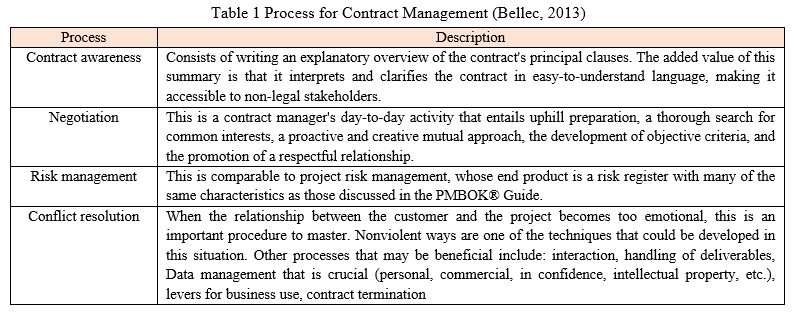
C. Claims
There are different authors who has defined claims in different manners. Most of them agrees on the same point that a claim is a contract adjustment due to changes or additions to the original contract. A claim is defined by the Canadian Law dictionary as an ‘Assertion to the right to remedy, relief or property’ or a ‘failure to fulfill obligations under the contract’Construction industry is such a platform where people and different stakeholders with different priorities takes part with different knowledge of the industry. Stakeholders from different occupations in this complex setting each have their own goals and expect to maximize their own gains. Conflicts are unavoidable in the construction sector due to differences in perceptions among project participants. If confrontations aren't handled properly, they can soon devolve into disputes. One of the biggest things that prevents a building project from being completed properly is disputes. As a result, it is critical to understand the sources of disagreements in order to execute the construction project on time, on budget, and with the intended quality (Emre Cakmak, 2014).Construction disputes happen fairly often; they are a reality on every construction project and could happen at any point in time during the design or construction phase of the project (Hall, 2002). Construction conflicts vary in shape, scale, and complexity, but they always have one thing in common: they are time and money consuming, and they frequently result in the severance of individual and excellent working relationships (Assah-Kissiedu, 2010).Causes to arise claims in construction Industry - In the construction industry, it is very rare to see any work to be completed without any changes. Although a lot of efforts has been put to make the construction contracts but a perfect document to resolve these claims rising disputes are very rare. As a result dispute arises, usually due to change in the original design, differing site conditions, discoordination among different stakeholders and other factors. According to Thomas, there are some of the factors which lead to the disputes are Poor planning & scheduling, Scope changes, Design Discrepancies, Defective specifications, Ambiguous instructions, Errors & omissions, Work Suspension, Acts of God (Shuib, 2011).

Fundamentals of Claim Management
To control the claims, stakeholders or parties who are involved in the project should have a good construction claim management. When we talk about the problems associated with the claims, it is very much important to see the associated party to that particular claim and who is responsible for that claim and how it is impacting the cost and time parameters related to the projects. (Norazian Mohammad Yusuwana, 2013) .

D. Conflicts & Disputes
The complexity of today's construction projects is increasing. Construction is a process in which disputes are nearly guaranteed due to the complicated, interrelated, and protracted process of designing and building (R. McManamy, 1994). Furthermore, using multidisciplinary teams in a building project can lead to disagreements between the participants. Conflict and conflicts appear to be an unavoidable part of the construction industry, especially when most building projects are fraught with unknowns (Whitfield, 1994).
Causes of Disputes in the construction industry - When we say and concentrate upon the disputes and want to reduce it, main common factor is to keep in mind is the origin (P. Mitropoulos, 2001). A lot of research has been carried out in the construction sector, there are a lot of variables that can lead to conflict and disputes, and there are a lot of variables that can lead to conflict and disputes. Construction disputes, according to (Hons, 1979), have its own instinctive nature and characteristics, and hence the sources of disputes will differ from one project to the next. According to his research, there are five basic drivers of construction disputes: contract document flaws, defects, or omissions, failure of someone to count the cost of an activity at the start, altered condition, consumer reaction, and persons involved. Behavioral issues, contractual issues, and technological issues owing to ambiguity and lack of experience are three major underlying causes of conflicts, according to (Williamson, 1979).
E. Contracts in India
In India, the construction industry is the economy's second greatest contributor. It accounts for roughly 8% of India's Gross Domestic Product (GDP) (Shirish Sankhe, 2020). It also brings in the second-largest amount of foreign direct investment (FDI) into the country (Hindu, 2021). This industry has one of the highest employment rates. The construction and development industry employs a total of 40 million people (including indirect jobs) and generates an average of 2.7 new jobs for every lakh rupee invested (Today, 2020). Infrastructure in quickly developing countries such as India is improving, and it is prospering in both the commercial and public sectors. Government expenditure isn't well-monitored after it's completed, especially when it comes to asset upkeep. (Gopikrishnan Seshadhri, 2018). When it comes to contracts, finance is one of the most important things to consider, and when it comes to sustainable buildings, all of these factors are taken into account (Basu, et al., 2017).
In the Indian construction business, there are no standard forms of contracts. In India, unlike the United Kingdom or the United States of America, we do not have distinct construction regulations. Construction and engineering contracts are one of the types of contracts covered by the Indian Contract Act of 1872. The majority of these contracts are for civil engineering work. Any large contract including features of civil engineering, however, is commonly referred to as a construction contract (Kamath, 2021). Government housing projects cost a lot of money to build, and the upkeep of these assets costs a lot of money as well. To assure performance, the facility maintenance agency is responsible for the expenditures made on these assets. (Seshadhri & Paul, 2018). Industrialization and modernization have a significant impact on the construction industry, as well as the development of infrastructure in all linked industries. When calibrated with project execution methods, modern and advanced devices can prove to be a time-saving, error-free solution with a high-quality end product (Rahul Kumar Gupta, 2022).
Apart from the FIDIC Contracts, other contracts are often utilized, such as those mentioned by the Institution of Civil Engineers (ICE) and the Indian Institute of Architects (IIA). Government construction authorities, such as the National Highway Authority of India, implement their own contracts as standard contracts in accordance with the needs of the departments, particularly for public-private partnership projects (NHAI). Many government departments, including the Public Works Department, Delhi Metro Rail Corporation, Indian Oil Corporation, National Building Construction Corporation, Central Public Works Departments, and others, have their own standard contract forms (Sumeet Kachwaha, 2021). The exponential rise in the number of people impacted caused a demand-supply imbalance, increasing the strain on healthcare systems. (Ruchita Dasgupta, 2021). An energy efficiency retrofit is any alteration made to an existing structure or the physical and operational upgrading of a building system that improves energy performance. (Chaitali Basu, 2019). Fire is very much prone to any of the building and it can cause to ton of losses. (Neha Kumari, 2022)
India's construction industry is booming, with numerous current projects, and it is the country's third largest contributor to economic growth. Contracts are an integral element of every construction project's process. Most of the public infrastructure projects in India are carried out through central public agencies like Central Public Works Department (CPWD). In India, the CPWD's GCC is the most used contractual framework for construction. Considering the difficulties raised in the literature review, the GCC structure has scarcely received revisions over the years as a result of such studies. Due to the influence of international contract papers (verbatim) and the necessity to correspond with the interests of foreign financial institutions such as the World Bank and Asian Development Bank, the GCC format has recently improved (ADB). (Paul, 2019).
- Security Related Clauses (SCR) - These type of clauses basically deal with securities. It is related to every stakeholders related to work like owner, contractor & labour as can be seen in the clauses. Clause 1 - Performance Guarantee (It is basically from contractor side to perform the work satisfactorily to the owner), Clause 10B – Secured Advance on Materials (From owner to contractor for fetching materials like steel, brick, stone aggregate etc. – non-perishable material.) & clause 41 - Release of Security deposit after labour clearance (It is to assure that there any no dues to any labour from contractor side.
- Time Related Clauses (TRC) – These type of clauses basically deal with time from the contractor and owner perspective. Clause 2 - Compensation for Delay (To the owner from contractor for delaying the project), Clause 5 - Time and Extension for Delay ( Levy for compensation to the contractor)
- Type of Contract Related Clauses (TCRC) - These type of clauses basically deal with contracts. There are different type of contracts and claims are different for each type of contracts. Clause 3 – When Contract can be Determined, Clause 27 – Lump sum Provisions in Tender.
F. General Condition of Contract
The rights, obligations, and relationships of the parties concerned are enumerated in the general conditions section of the contract form. It specifies the obligations and privileges of each contractual party, as well as the norms that will regulate the relationship. GCC of CPWD, broadly covers the points mainly related to client, contractor, time, cost, quality, disputes etc. The clauses and claims pertaining to these clauses can be classified in different sub heads.
Being complex in nature construction projects, contracts are also becoming too much complex to resolve and mitigate the risks. Keeping these points in mind CPWD is open for suggestions to amend the clauses to give a proper balance of mitigation risks and comply all of the changes and trying to fill the loopholes which are there in the contract. Recently it has been seen that amendment has been done in 2008, 2014, and 2019.
- Categories of General Conditions - General conditions encompass every aspect of the project which deals a variety of dynamics which can arise in construction projects. Categorization of GCC can be done in several parameters as shown in the table 3. Studies which has been done before and through FIDIC it can be seen that whole clauses has been divided on terms of employer, contractor, engineer, sub-contractor, staff and labor, plant, materials & workmanship, commencement, delays and suspension etc.

a. Security Related Clauses (SCR) - These type of clauses basically deal with securities. It is related to every stakeholders related to work like owner, contractor & labour as can be seen in the clauses. Clause 1 - Performance Guarantee (It is basically from contractor side to perform the work satisfactorily to the owner), Clause 10B – Secured Advance on Materials (From owner to contractor for fetching materials like steel, brick, stone aggregate etc. – non-perishable material.) & clause 41 - Release of Security deposit after labour clearance (It is to assure that there any no dues to any labour from contractor side.
b. Time Related Clauses (TRC) – These type of clauses basically deal with time from the contractor and owner perspective. Clause 2 - Compensation for Delay (To the owner from contractor for delaying the project), Clause 5 - Time and Extension for Delay ( Levy for compensation to the contractor)
c. Type of Contract Related Clauses (TCRC) - These type of clauses basically deal with contracts. There are different type of contracts and claims are different for each type of contracts. Clause 3 – When Contract can be Determined, Clause 27 – Lump sum Provisions in Tender

d. Payment & Cost Related (PCR) – These type of clauses basically deal with payments to the contractor and it basically directly proportional to delay of projects and it automatically will increase the cost as time is related to cost directly and it will lead to claims and disputes. Clause 4 - Contractor liable to pay Compensation even if action not taken under Clause 3, Clause7 - Payment of intermediate certificate to be regarded as Advances, Clause 7A , Clause 9 - Payment of Final Bill, Clause 10CA - Payment due to variation in price of materials after receipt of tender, Clause 12 - Deviation, Extra Items and Pricing, Clause 18A - Recovery of Compensation paid to Workmen, Clause 18B – Ensuring Payment and Amenities to Workers if Contractor fails.
e. Statutory Related Clauses (SRC) - These type of clauses basically deal with the statutory taxes and bodies which ultimately rise to give rise to claims and disputes. Clause 10C - Payment on Account of Increase in Prices/Wages due to Statutory Order(s), Clause 19 - Labour Laws to be complied by the Contractor, Clause 19A , Clause 19B - Payment of Wages , Clause 19L – Contribution of EPF and ESI , Clause 20 – Minimum Wages Act to be Complied With , Clause 33 - Levy/Taxes payable by Contractor , Clause 34 – Conditions For reimbursement of levy/taxes if levied after receipt of Tenders , Clause 40 – Apprentices Act provisions to be complied with
f. Work Related Clauses (WRC) - These type of clauses basically deal with work related aspects like specifications, plants, equipment’s, scope of work etc. It includes Clause 11 - Work to be Executed in Accordance with Specifications, Drawings, Orders etc. , Clause 13 – Foreclosure of contract due to Abandonment or Reduction in Scope of Work, Clause 14 - Carrying out part work at-risk & cost of contractor, Clause 15 – Suspension of Work, Clause 16 - Action in case Work not done as per Specifications, Clause 18 - contractor to Supply Tools & Plants etc., Clause 30 – Unfiltered water Supply, Clause 30A – Alternate water Arrangements , Clause 31 - Hire of Plant & Machinery, Clause 32- Employment of Technical Staff and employees
g. Others – This is miscellaneous category and it includes Clause 8 – Completion Certificate and Completion Plans , Clause 23 – Changes in firm’s Constitution to be Intimated, Clause 24 - Life Cycle Cost, Clause 25 – Settlement of Disputes & Arbitration, Clause 28 - Action where no Specifications are Specified, Clause 29 – Withholding and lien in respect of sum due from Contractor, Clause 35 – Termination of Contract on death of contractor, Clause 36 - If relative working in CPWD then the contractor not allowed to tender, Clause 37 - No Gazetted Engineer to work as Contractor within one year of retirement , Clause 38 – Theoretical conception of Material, Clause 39 – Compensation during warlike situations
2. Amendment in General Conditions of Contract - In India, the CPWD's GCC is the most used contractual framework for construction. Unfortunately, there hasn't been enough study done to prove its effectiveness in terms of preventing disputes through proper claim management. Because of this, the GCC organization has barely undergone revisions over the years. Research, taking into account the issues raised by the literature review. In recent years, The GCC format has improved as a result of international influence. Contract documents (verbatim) must be aligned with international interests. World Bank and Asian Development Bank are two examples of funding institutions (ADB) (Paul, 2019). In previous years, the GCC of the CPWD has been amended. Changes were made in 2008, 2014, 2019, and other years, according to the reports. These modifications were made to make the contract less unclear and more useful in completing the job on schedule. Some of the clauses stated in the table below have been amended in 2019. If we look at the timeline, we can see that some of the sections on which frequent claims are based are being updated on a regular basis based on recommendations to close gaps and ambiguities. Clauses such as clause 2, clause 5, and so on.
It has been observed in amended clauses that some of the factors has been incorporated from owner point of view and some of it are from contractor relaxation point of view. Some of the things like cost index and price escalation has been kept in mind and then an increase or decrease in the rate of interest has been done.
III. CASE STUDIES DATA COLLECTION
A. Introduction
Twenty real-life arbitration conflicts were gathered for analysis from different arbitrators. Former CPWD personnel who had handled many of the department's arbitrations were chosen as arbitrators, and they were asked to offer some of their cases for examination after outlining the purpose and objectives. Of the research to keep the data and parameters as homogeneous as possible, the arbitration cases were collected solely from the CPWD, which is administered under the CPWD's GCC.
To protect confidentially, each arbitration case was issued a case number, and a log sheet was created to record the specifics of each case for future reference. The paper will henceforth treat each dispute as a "case," with neither the name of the arbitrator nor the circumstances of the arbitration dispute being revealed. For each case, documents relevant to the statement of claims and counterclaims, rejoinders, and award were gathered.
The repetitiveness and validity of the claims presented for arbitration were examined to see if there was a link between the occurrence of a claim and the contract circumstances that accompanied it. In the following section of this post, we'll go over the step-by-step approach that was employed to conduct the study.
B. Methodology
Methodology adopted in this thesis to understand the case study and relate it to the final outcome to understand the claims in any of the dispute is simple. As in previous chapter the clauses has been divided into different sections like statutory related, time related, cost and payment related, 10 cases before 2019 and 10 cases after 2019 has been taken and a claim data sheet has been made as per that. The claim datasheet will be consisting the claims, clauses pertaining to that claims, reasons, counterclaims, claimant amount, rewards and what was the arbitrator finding in that particular case.
C. Case Datasheet
In 2019, the GCC of the CPWD was amended. Essentially, there are 13 GCCs that have been updated and some changes have been made. Cases prior to 2019 were examined to determine which types of claims were submitted by the claimant and how much compensation was awarded to that claim prior to the change. The primary concept is to figure out whether the claim pattern is changing or staying the same before and after amendment. A table for one example was displayed, and all 20 cases were studied in the same way. The tables show the claims for all of the cases. Cases before 2019

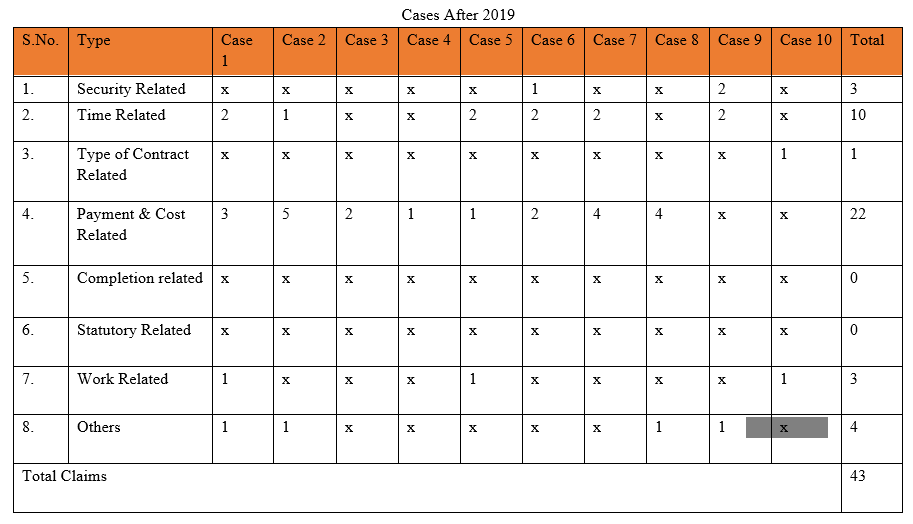
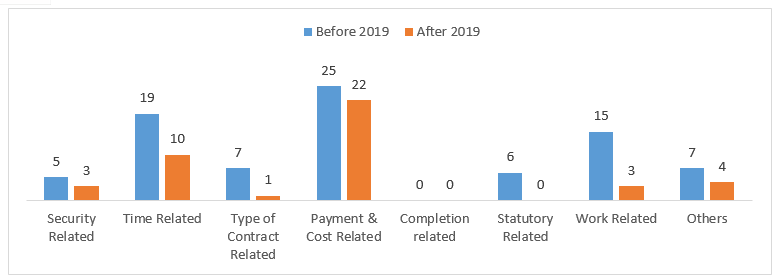
The cases which have been taken before and after 2019, though the number of cases are less, a conclusion can be drawn out from the study. It can be seen that the cause related to the cost and payment factor is very much dominating in both the cases before and after the amendment. It has been found that number of claims are decreasing after the amendment.
By looking into the cases before and after amendment the reasons for these claims have been identified. Reasons for these claims has been listed in the table below
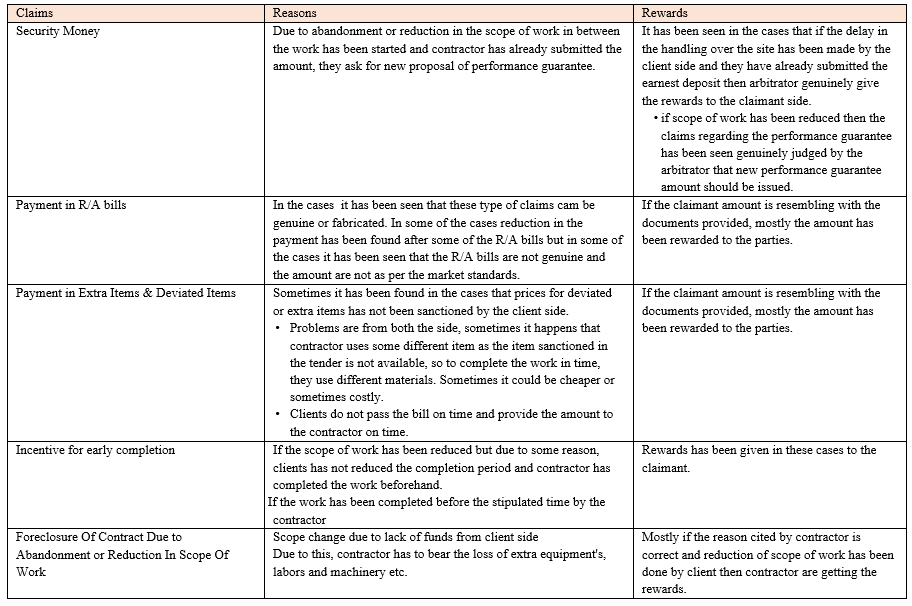
To validate and know other reasons for the claims an interview has been conducted with professional experts. Other factors are listed in the below table.
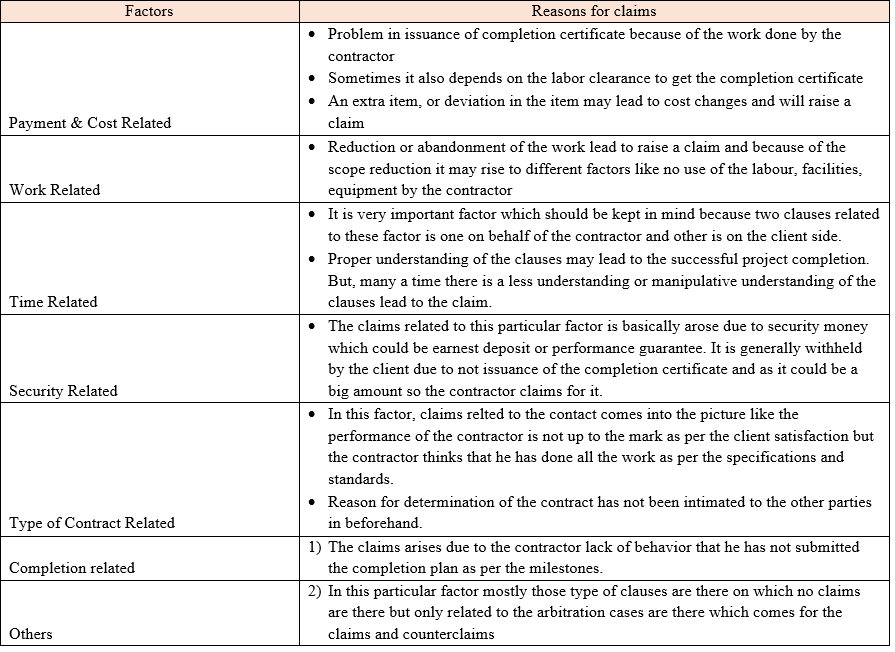
|
Others |
|
D. Interviews
???????Date Collection Mode - The interview method comprises presenting oral-verbal stimuli and receiving responses in the form of oral-verbal responses. Personal interviews and, if possible, telephone interviews can be employed in this strategy. The respondent can provide more detailed details.
- It is possible to obtain clarifications and explanations.
- Complete responses are possible.
- Complete control over the respondents' surroundings.
- Requires the respondent to expend less time and effort.
- Illiterates can use it because it is flexible.
- There is less ambiguity.
- Language adaptability.
- Take note of any further details.
Through this approach, I've noticed that one-line answers are always dependent on what's socially acceptable, and depend on what everyone says in the market, but when asked again in a different way, the actual reality emerges. As a result, the interview is a good way to collect data since it leads to unbiased and unpolished responses, which lend credibility to any research.
E. Methodology
The interviews at this stage was basically to understand the relationship of claims, amendment, GCC and nature of work. Several telephonic interviews were conducted to know the expert opinion. The factors and ranking has already been found through the cases taken into previous segments but it was very necessary to understand the expert opinion on amendments. The interview was basically an open discussion where experts were allowed to comment on any spectrum to lead to an unbiased decision. This group of expert professional comprises of arbitrators from CPWD who were either retired from the organizations or working in the field of arbitration. They all were registered arbitrators by the CPWD. In total 30 interviews has been conducted in which 10 arbitrators were having more than 20 years of experience, 16 were having 15-20 years of work experience and 4 were having 10-15 years of work experience.
F. Interview Analysis
- Thematic Analysis - The data was analyzed using a qualitative analytical method based on thematic analysis. To begin, audios and written notes were used to create a transcript. The second stage was to code the provided data by rereading and looking for patterns in the various interviews. The generated codes were then combined with several categories that appeared multiple times in the transcripts, and the theme was discovered.
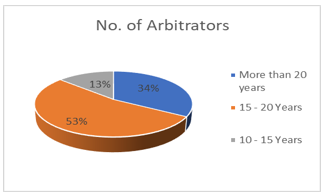
G. Interview Results
The interview has taken and the framework of the interview has been thought in such a way that it was revolving around the claims and amendments. It was actually done by keeping the hypothesis in mind that “Amendments helped in reduction of claims”. The interview has been conducted and some of the themes has been analyzed which is actually the outcome.
- Faith in GCC - The first theme has been found regarding the faith in GCC. Most of the arbitrators were pointing out that involved parties are having faith in GCC that it has been designed in such a way that it helps in resolving the disputes in a great manner. They told that although it has been framed in a manner by keeping all the parties in mind there are some loopholes in GCC. They agreed that some definitions and clauses should be taken care of to show the direct relationship but we can’t say directly that there is a loophole. Faith is something which sets a mindset and helps in reduction of claims.
- Amendments - The second theme was found amendments and claim reduction, most of the professional pointed out that when an amendments has been done there has always been seen an improvement in terms of getting claims. It has also been pointed out that it positively impact the dispute resolution also but the impact would be shown if the respondent and claimant will want it but it is questionable. It also has been told that sometimes reduction of claims or nature of claims depends on type of work and scale of the project too.
- Positiveness - The third theme found was about the opinion regarding the amendments. Nearly all of them were positive regarding it and said that amendments are positive and we can see as a step towards the progress. Our wisdom flows in a positive direction, every amendments in any act or GCC it is good. Some expert’s pointed out that it is something which should be done regularly and quickly.
- Balanced framework - The fourth theme found regarding the framework of clauses and it has been told that after 2004 when the amendments has been done the outline of GCC has totally been changed as it was felt that in any of the project there are a lot of stakeholders involved and all of them are equally important. When we talk abbot the contractor and client both of them are like wheel of any cycle so it should not to be biased to anyone and after 2003 it has been modified slowly to be equal to both parties. Nowadays it is not biased to anyone as such.
- Work completion- The last theme found was the about the work completion. It has been told that the claims actually hamper the work in progress as the contractor doesn’t give their 100% because of this. And the time is essence of the contract so sometimes claimant ignore little claims which doesn't cost them less.
H. Analysis & Conclusion
.
The cases which have been taken before and after 2019, though the number of cases are not sufficient enough but a conclusion can be drawn out from the study. It can be seen that the cause related to the cost and payment factor is very much dominating in both the cases before and after the amendment. As the amendment. It has been found that number of claims are decreasing after the amendment and ranking for the type of claims has also been changed before and after the amendment.
Looking at the factors for the effectiveness of amendment, an analysis has been done of the clauses that how amendments are actually fulfilling those factors of faith, balanced framework and positiveness
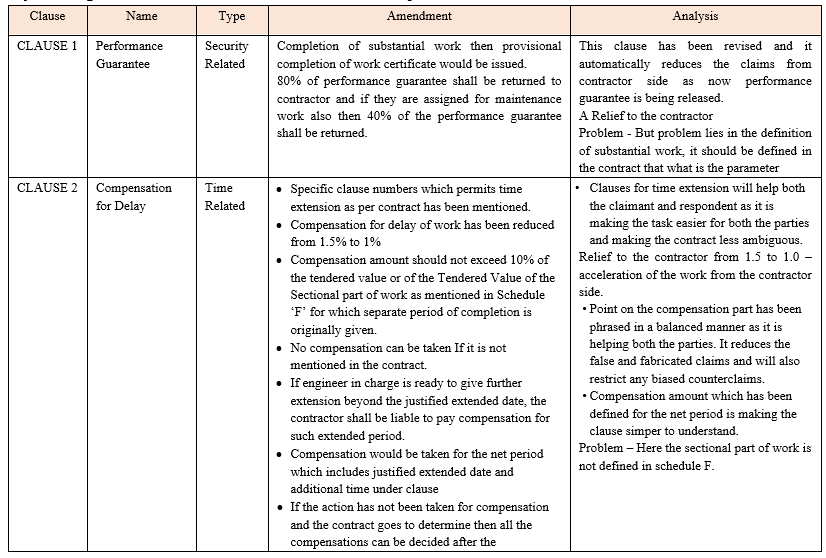
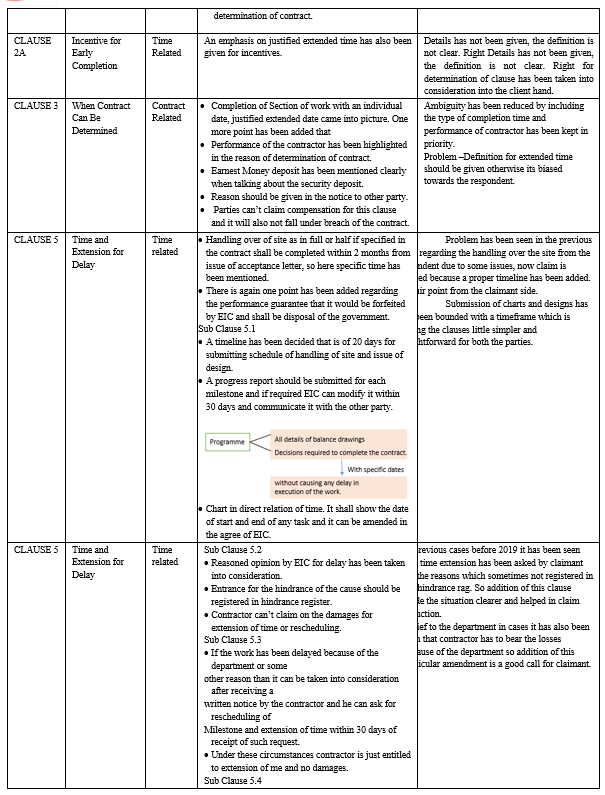
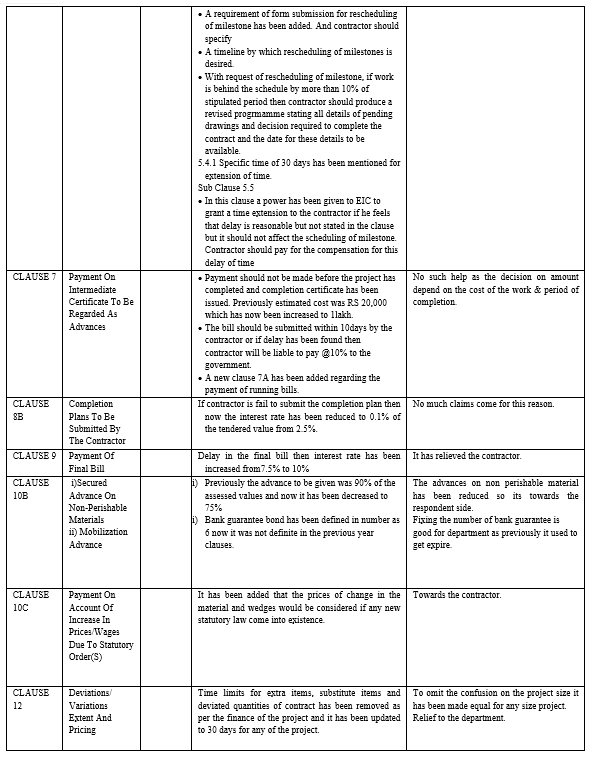
After analyzing each clauses it has been related to the categorized factors before and after amendment that how it has impacted the scenario of arbitration and claims.
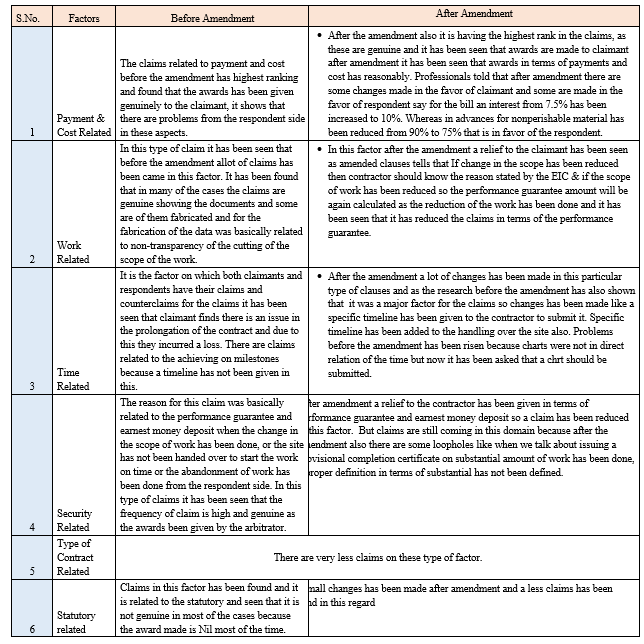
It was discovered that claims were reduced in cases where adjustments were made, and experts' insights also revealed that amendments are particularly beneficial to stakeholders. Whenever adjustments have been made, the parties involved have perceived a positive aspect. However, as we all know, when a large number of parties are involved in a project, arbitration and claims are almost inevitable. As a result, the GCC's major goal should be to rapidly and conveniently resolve disputes because it is impossible to ignore allegations in building projects because stakeholders' interpretation differs
I. Recommendations
Following an analysis of the cases and interviews with many professionals, it was discovered that there are several spots and loopholes in GCC where we may work to reduce claims automatically. It has been discovered that suggestions can be issued on two different bases. One is on a broad basis that can be incorporated into terms in future amendments, while the other is on revised clauses that need to be improved.
General –
- Frequency of the GCC - It should be consistent with other acts, such as the Indian Contract Act and the Arbitration and Conciliation Act, because there is a gap. The claimant claims interest on the withheld amount due to contract extension, which is not mentioned anywhere in the GCC, but awards have been given for the same based on the Indian contract legislation.
- Constitution of DRC - Another item to highlight is that there is a general lack of willingness and accountability on the part of departmental officers in executing reciprocal commitments on time, as well as on the part of the departmental DRC in resolving disputes. The DRC should follow the NHAI's DRB model, in which DRB members are a mix of retired officials from the same and separate departments who are uninterested in any party. As a result, if the GCC is to be changed, the DRC Constitution must also be changed.
- Responsibilities to Engineer in Charge - Engineer in charge's responsibilities should be incorporated into the clauses, and he should be given the authority to make decisions on his own based on the circumstances on the job site, because the engineer is the focal point of the work in CPWD, and if he is alert and solves the contractor's problems, claims will automatically decrease.
- Escalation Factor- Although the share of escalation is not mentioned in the contract, it has been noticed that if the project is stretching, it should be provided to the claimant and a court decision should be made. As a result, the GCC clauses should address price increase.
- Special Condition of Contract – The importance of SCC in any project should be clearly stated in the guidelines, and the clauses mentioned in the SCC should be carefully defined to connect to the project. Because construction projects differ in nature, the claims that arise are primarily tied to the project's unique circumstances. As a result, SCC should be emphasized more.
J. Clauses Related
- Security Related – It has been observed that in the amendments a new parameter has been added regarding release of the security deposit and it states if substantial amount of work has been done 90% of security deposit should be released. The point which has been added here is a great move towards the resolving the disputes regarding the claims related to it. But one point must be addressed here is that where the definition of substantial work has been defined in the contract and what is the parameter weather its physical completion, financial completion or how much percentage of it should be mentioned in the contracts.
- Time Related – While analyzing the cases it has been found that time related claims are also very much common and repeatedly coming in the disputes. Amendment in 2019 has been made in these clauses. A lot of points like defining the timeframe for handling over the site and compensation for delay from 1.5% to 1% helped the contractors and helped in accelerating the work. When it comes about the sectional part of the work it should be defined in schedule F correctly.
- Type of Contract Related – In cases a lot of claims has been found due to abandonment of work and factors related to it. In the amendments changes has been made to keep the contract easier to understand and non-ambiguous but the Definition for extended time should be given otherwise it’s biased towards the respondent.
- Payment & Cost Related – Cash flow and payment is major factor for any disputes. As time is passing a good amendments has been made in the GCC contract but when we talk about reducing claims or resolving disputes quickly one point should be added in the GCC that timely payment must be made by the client to the contractor. Sometimes it has also been seen that contractor doesn't give the payment receipt on time. So, provision in the GCC should be made on the periodic payments and quicker submission of bills from the contractor side too. Another point which should be added in the GCC is about the definition of extra pricing and deviation. If the definition would be there in the clauses itself then most of the claims will automatically resolved at the first place.
Conclusion
The goal of this thesis was to see if amendments done in GCC has reduced or heled in reduction of claims in the arbitration cases and it has been found through the cases and interviews that factors due to amendments has always been on the positive hand side. There are twenty public works arbitration, which is governed by the CPWD\'s GCC, was put up for discussion. The study and its claims were investigated and analyzed. According to the findings, the majority of the origins of many of the claims can be traced back to contract terms and modifications. The number of claims can be reduced significantly under contract conditions. To that purpose, some suggestions for general adjustments have been made. Contract clauses that can assist in reducing claims. Dispute resolution will always be a continuous process since, no matter what, there will always be disagreements. When it comes to the general terms of a contract, the key goal is to keep the focus on resolving disputes swiftly and efficiently. When amendments are made, both sides should be considered, and adjustments should be made. Though the formalized GCC is addressing the issues in some ways, it is practically impossible to avoid disputes in construction projects because there are so many players. The analysis of the changed clauses and comparisons of the new clauses to the old ones have clearly revealed the positiveness of the parties because it has been observed that the formulation is not prejudiced towards either one of the parties, but rather addresses the problems of both parties equally. Because we all know that the claims will not be completed in their entirety, some of the items made as recommendations may be considered for future changes
References
[1] Acharya, N. L. Y. &. I. H., 2006. Conflicting factors in construction projects: Korean perspective.. Journal of Engineering Construction and Architectural Management,, pp. 543-566. [2] Aiswarya Sreekumar, D. V. K. P. S. K. S. S. D., 2022. 9. Sreekumar, A., Paul, D. V. K., Solanki, S. K., & Dua, S. (2002). Sustainable Retrofit for Adaptive Building Reuse–A Facility Management Approach for Highlighting and Cataloguing Deficiencies for Retrofit Decision Making.. Journal of Multidisciplinary Innovative Research , pp. 21-37. [3] Assah-Kissiedu, M. F. F. a. B. E., 2010. Triggers of Disputes within the Ghanaian Construction Industry. Journal of Construction, Volume 3, Number 2. [4] Bellec, M. |. C. O., 2013. Contract manager, a new project team member?. EMEA, Barcelona, Spain, Newtown Square, PA: Project Management Institute.. [5] BOWMANS, 2020. A GUIDE TO CONSTRUCTION CONTRACTS, Africa: BOWMANS. [6] C. William Ibbs, D. B. A., 2012. IMPACT OF VARIOUS CONSTRUCTION CONTRACT CLAUSES. J. Constr. Eng. Manage., p. 21. [7] C. William Ibbs, D. B. A. A. M. A., 1987. IMPACT OF VARIOUS CONSTRUCTION. J. Constr. Eng. Manage. 1987.113:501-521., p. 21. [8] Chaitali Basu, V. K. Paul. M. G. M. S., 2017. Innovations for Energy Efficiency Retrofitting Financing in Construction Sector: Indian Perspective.. International Conference on Sustainable Infrastructure, p. 199–210. https://doi.org/10.1061/9780784481202.019. [9] Chaitali Basu, V. K. Paul. M. M. S., 2019. PERFORMANCE INDICATORS FOR ENERGY EFFICIENCY RETROFITTING IN MULTIFAMILY RESIDENTIAL BUILDINGS.. Journal of Green Green Building, pp. 14(2), 109-136. https://doi.org/10.3992/1943-4618.14.2.109. [10] Chaitanya Khekale, N. F., 2013. Management of Claims and Disputes in Construction Industry. International Journal of Science and Research. [11] CPWD, 2016. Goverment of India Ministry of Housing & Urban Affairs Central Public Works Departments. Delhi(Delhi): s.n. [12] Emre Cakmak, P. I. C., 2013. An Analysis of Causes of Disputes in the Construction Industry Using Analytical Network Process. International Journal of Science and Research, pp. 183-187. [13] Emre Cakmak, P. I. C., 2014. An analysis of causes of disputes in the construction industry using analytical network process. ELSEVEIR, p. 183 – 187. [14] Eshetu Zenebe, P. T. A. M., 2016. Contract claim Analysis on Building Construction Project in Addis Ababa: A case study at Yeka Sub city. International Journal Of Scientific & Engineering Research, , p. 7. [15] Fenn, P. L. D. &. S. C., 1997. Conflict and dispute in construction.. Construction Management and Economics, pp. 15,6, 513-518. [16] Gopikrishnan Seshadhri, V. K. P., 2018. MEASURING SATISFACTION WITH USER REQUIREMENT RELATED BUILDING PERFORMANCE ATTRIBUTES: A QUESTIONNAIRE. pp. 9(1), 14. [17] Gopikrishnan Seshadhri, V. K. P., 2018. MEASURING SATISFACTION WITH USER REQUIREMENT RELATED BUILDING PERFORMANCE ATTRIBUTES: A QUESTIONNAIRE. pp. 9(1), 14. [18] Gopikrishnan Seshadhri, V. K. P., 2018. User Satisfaction Index: An Indicator on Building Performance. Journal of civil Engineering & Structures, pp. 2(1), 14-33 http://dx.doi.org/10.21859/jces.02012 . [19] Gopikrishnan S, V. K., 2019. User centric facility maintenance model for public housing. pp. 37(11/12), 839-859. https://doi.org10.1108/F-09-2018-0110. [20] Hall, J. M., 2002. Ineffective communication: Common Causes of Construction Disputes Alliance?s Advisory Council Legal Notes. [21] Hartman, F., 2000. Don\'t Park Your Brain Outside—A Practical Guide to Improving Shareholder Value With SMART Management. Project management Institute. [22] Hesham A. Abdel-Khalek, R. F. A. I. A. A., 2019. Prepare and analysis for claims in construction projects using Primavera Contract Management. Alexandria Engineering Journal, p. 11. [23] Hindu, T., 2021. FDI inflow touches $82 bn in FY21. The Hindu. [24] Hons, H. M., 1979. reventing and solving construction contract disputes. Van Nostrand Reinhold. [25] K.C. Iyer, N. C. G. J., 2008. Understanding time delay disputes in construction contracts. International Journal of Project Management , p. 11. [26] Kamath, N., 2021. Issues related to construction contracts in India. [Online] Available at: https://blog.ipleaders.in/issues-related-to-construction-contracts-in-india/ [27] Law, T., 2021. History of the Indian Contract Act 1872. [Online] Available at: https://www.lawteacher.net/free-law-essays/contract-law/history-of-the-indian-contract-act-1872-contract-law-essay.php [28] Leveau, G., 2013. La pratique du contract management.. Gualino-Lextenso éd.. [29] Malyavin, I., 2014. Construction Contracts and Contract variations. Auckland University of Technology, p. 2. [30] maxwellgoko, 2012 . Definition and brief history of the Law of Contract.. [Online] Available at: https://www.kenyaplex.com/resources/2964-definition-and-brief-history-of-the-law-of-contract.aspx [31] Neha Kumari, T. S. S. K. S., 2022. Analysis of Smoke Production and Movement in Shopping Malls/Centers. Journal of Town Planning and Management. [32] Norazian Mohammad Yusuwana, H. A., 2013. Issues Associated with Extension of Time (EOT) Claim in Malaysian Construction Industry. nternational Journal of Science and Research , pp. 740-749. [33] P. Mitropoulos, ,. &. G. H., 2001. Model for understanding, preventing and resolving project disputes. Journal of Construction Engineering And Management, pp. 223-231. [34] P.I. Cakmak, ,. &. E. C., 2013. An analysis of causes of disputes in the construction industry using analytical hierarchy process (AHP). University Park, Pennsylvania, USA. , The Pennsylvania State University, . [35] Padia, S., 2022. National Investment Promotion & Facilitation Agency. [Online] Available at: https://www.investindia.gov.in/sector/construction [36] Parnika Yadav, S. K. S. K. S. V. K. P., 2002. A Review of Retrofitting Techniques of Masonry Structures.. Journal of Multidisciplinary Innovative Research, pp. 12-20. [37] Paul, A. M. a. V. K., 2019. Analysis of Claims in Public Works Construction Contracts in India. ournal of Construction in Developing Countries, pp. 3-5. [38] Paul, V. K. & Basu, C., 2016. Scenario Planning and Risk Failure Mode Effect and Analysis (RFMEA) based Management. Journal of Construction Engineering & Project Management 6(2), pp. 24-29. [39] R. McManamy, 1994. Indusrty pounds away at disputes. Engineering news record, pp. 24,3. [40] Rahul Kumar Gupta, V. P. S. K. S., 2022. Optimization of Project Progress Using 3D Laser Scanning Technique. Journal of Architecture and Infrastructure Planning , pp. 21-45. [41] Ruchita Dasgupta, S. K. S. V. P., 2021. Post-pandemic impact on planning of district. International journal of the Built Environment and Asset Management, pp. 2(1),1 https://doi.org/10.1504/IJBEAM.2021.10043515. [42] Shirish Sankhe, A. M., 2020. Construction and Manufacturing Could Be Our Growth Propellants, Mint. [Online] Available at: https://www.livemint.com/opinion/online-views/construction-and-manufacturing-could-be-our-growth-propellants-11603031302126.html [43] Shuib, N. J. H. A. T. N., 2011. Factors of Conflict in Construction Industry: A Literature Review. ELSEVIER, pp. 193-202. [44] Smith, M., 1992. Facing up to conflict in construction. Manchester, s.n. [45] Sumeet Kachwaha, D. R., 2021. ICLG.com. [Online] Available at: https://iclg.com/practice-areas/construction-and-engineering-law-laws-and-regulations/india [46] Table, C. V., n.d. Critical Values of the Chi-Square Distribution. [Online] Available at: https://www.itl.nist.gov/div898/handbook/eda/section3/eda3674.htm [47] Today, I., 2020. Here\'s why Indian construction industry needs more skills in this fast-paced era, Delhi: India Today. [48] Vidushi Kasana, V. P. S. K. S., 2022. Framework for Rehabilitation of Buildings to Improve Health, Hygiene, and Comfort of Occupants. INTERNATIONAL JOURNAL OF TOWN PLANNING AND MANAGEMENT, pp. 9, 38-46. [49] Whitfield, J., 1994. Conflicts in construction, avoiding, managing and resolving.. Macmillan Press. [50] Williamson, O., 1979. Transaction cost economics: The governance of contractual relations. ournal of Law Economy, pp. 22, 233-261. [51] Yiu, S. O. C. a. T. W., 2006. Are Construction Disputes Inevitable?. IEEE Transactions on Engineering Management. Zaghloul, R. |. H. F. T., 2002. Construction contracts and risk allocation. Project management Institute
Copyright
Copyright © 2022 Nidhi Gupta, Sushil Kumar Solanki, Manoj Mittal. This is an open access article distributed under the Creative Commons Attribution License, which permits uAfter analyzing each clauses it has been related to the categorized factors before and after amendment that how it has impacted the scenario of arbitration and claims. After analyzing each clauses it has been related to the categorized factors before and after amendment that how it has impacted the scenario of arbitration and claims. After analyzing each clauses it has been related to the categorized factors before and after amendment that how it has impacted the scenario of arbitration and claims. nrestricted use, distribution, and reproduction in any medium, provided the original work is properly cited.

Download Paper
Paper Id : IJRASET41946
Publish Date : 2022-04-27
ISSN : 2321-9653
Publisher Name : IJRASET
DOI Link : Click Here
 Submit Paper Online
Submit Paper Online

